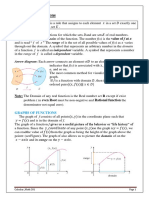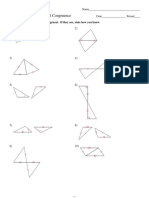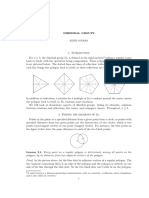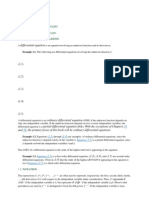Introduction To Exponential Functions 32015
Uploaded by
Leslie CameronIntroduction To Exponential Functions 32015
Uploaded by
Leslie CameronIntroduction to Exponential Functions
Today, we will be investigating the similarities and/or differences between three different
types of graphs: y = 2x, y = 2x2, and y = 2x.
Ex.
Graph the following functions using the table of values provided. Also calculate the
first and second differences for each:
i) y = 2x
x
-3
-2
-1
0
1
2
3
ii) y = 2x2
1st
2nd
diff. diff.
x
-3
-2
-1
0
1
2
3
iii) y = 2x
1st
2nd
diff. diff.
1st
2nd
diff. diff.
-3
-2
-1
0
1
2
3
a) Describe any similarities and/or differences you see for the equations of the functions.
b) Describe any similarities and/or differences you see for the graphs of the functions.
c) Describe any similarities and/or differences you see for the finite differences of the
functions.
SUMMARY PROPERTIES OF EXPONENTIAL FUNCTIONS
1. An exponential function is in the form ____________, where _____ is the base, and
_______ is the exponent.
2. _________ always passes through the point ___________.
3. No matter how small you make x, y will _________________. The graph will get
____________ and ___________ to the _____________, but will never touch it.
Graphs of Exponential Functions, y = abx, a=1
Ex.
i)
X
-2
-1
0
1
2
Graph each of the following exponential functions using the table of values provided on the
same grid. Calculate the first and the CONSTANT RATIO for each (the constant ratio is
when you divide consecutive first differences):
y = 2x
Y
ii) y = 4x
1st
diff.
Constant
Ratio
iii) y = 7x
1st
diff.
Constant
Ratio
-2
-1
0
1
2
-2
-1
0
1
2
a) How are these graphs similar?
b) How are these graphs different?
c) What does the constant ratio tell you?
d) How does the value of the base affect your graph?
e) What is the domain and range for all the graphs?
f) What is the x-intercept for each graph?
g) All three graphs have one point in common. What is it?
1st
diff.
Constant
Ratio
Ex.
i)
X
Graph each of the following exponential functions using the table of values provided on the
same grid. Calculate the first and the constant ratio for each:
1
y=
ii) y =
1st
diff.
-2
-1
0
1
2
Constant
Ratio
iii) y =
1st
diff.
Constant
Ratio
-2
-1
0
1
2
1st
diff.
Constant
Ratio
-2
-1
0
1
2
a) How are these graphs similar?
b) How are these graphs different?
c) What does the constant ratio tell you?
d) How does the value of the base affect your graph?
e) What is the domain and range for all the graphs?
f) What is the x-intercept for each graph?
g) All three graphs have one point in common. What is it?
DEFINTION:
An
is a line that a curve approaches more and
more closely, but never crosses or touches it on some portion of its domain.
SUMMARY PROPERTIES OF y=abx, a=1
A function in the form y=bx:
a)
if b>1
b)
if 0<b<1
c) has a y-intercept of
d) has an
e) has a domain of
f) has a range of
on the x-axis
You might also like
- Lie Groups by Hall - Unofficial Solutions For Chapter 1No ratings yetLie Groups by Hall - Unofficial Solutions For Chapter 12 pages
- 1 GR 11 Functions Graphs and Exercise Questions Answers100% (1)1 GR 11 Functions Graphs and Exercise Questions Answers12 pages
- Function and Application: Mathematics in The Modern World100% (1)Function and Application: Mathematics in The Modern World13 pages
- I. Concept/Digest With Base Characteristics of Exponential Functions of The FormNo ratings yetI. Concept/Digest With Base Characteristics of Exponential Functions of The Form2 pages
- GenMath_Q1_LAS6_Graphing-Exponential-FunctionsNo ratings yetGenMath_Q1_LAS6_Graphing-Exponential-Functions17 pages
- General Mathematics Quarter 1 Week 6: ExpectationsNo ratings yetGeneral Mathematics Quarter 1 Week 6: Expectations9 pages
- Beginning and Intermediate Algebra 6th Edition Lial Test Bank Download100% (29)Beginning and Intermediate Algebra 6th Edition Lial Test Bank Download44 pages
- Graphic Representation of Algebraic Expression: QA - Graphs-BasicsNo ratings yetGraphic Representation of Algebraic Expression: QA - Graphs-Basics10 pages
- Mathematics Grade 10 Term 3 Week 2_2020 (1)No ratings yetMathematics Grade 10 Term 3 Week 2_2020 (1)10 pages
- Graphing Exponential Functions: ObjectivesNo ratings yetGraphing Exponential Functions: Objectives7 pages
- Mathematics Review Notes - Introduction To Relations and Functions - University and Senior High School StudentNo ratings yetMathematics Review Notes - Introduction To Relations and Functions - University and Senior High School Student4 pages
- 2-1: Graphing Linear Relations and Functions: ObjectivesNo ratings yet2-1: Graphing Linear Relations and Functions: Objectives19 pages
- Functions Summary and Graph InterpretationNo ratings yetFunctions Summary and Graph Interpretation10 pages
- Student Solutions Manual to Accompany Economic Dynamics in Discrete Time, secondeditionFrom EverandStudent Solutions Manual to Accompany Economic Dynamics in Discrete Time, secondedition4.5/5 (2)
- Geometric Sequences: Algebra 1 Part 2: Module 4 Unit 3 Lesson 2No ratings yetGeometric Sequences: Algebra 1 Part 2: Module 4 Unit 3 Lesson 217 pages
- Lesson Notes Systems of Linear InequalitiesNo ratings yetLesson Notes Systems of Linear Inequalities3 pages
- Intersection of Exponential Functions 42215 HomeworkNo ratings yetIntersection of Exponential Functions 42215 Homework4 pages
- Algebra1 - Bridge To Alg2 - Module 2 Unit 3 ExamNo ratings yetAlgebra1 - Bridge To Alg2 - Module 2 Unit 3 Exam9 pages
- Theory and Examples Fifth Edition DurrettNo ratings yetTheory and Examples Fifth Edition Durrett62 pages
- 4-2 Writing Equations in Standard Form and Point Slope FormNo ratings yet4-2 Writing Equations in Standard Form and Point Slope Form19 pages
- Fredholm Properties of The Difference of OrthogonaNo ratings yetFredholm Properties of The Difference of Orthogona10 pages
- J.R. Porter and R.G. Woods, Extensions and Absolutes of Hausdorff Spaces (Springer, New YorkNo ratings yetJ.R. Porter and R.G. Woods, Extensions and Absolutes of Hausdorff Spaces (Springer, New York12 pages
- 2013 JC2 H2 Math Revision Lecture Solutions (MYE) Updated 15 May 2013 PDFNo ratings yet2013 JC2 H2 Math Revision Lecture Solutions (MYE) Updated 15 May 2013 PDF14 pages
- Ordinary Differential Equations: An Introduction To The Fundamentals Second Edition. Edition Howell All Chapters Instant Download100% (3)Ordinary Differential Equations: An Introduction To The Fundamentals Second Edition. Edition Howell All Chapters Instant Download62 pages
- 1220 Number Theory Problems - Third Edition100% (1)1220 Number Theory Problems - Third Edition165 pages
- 2021 Level LS Mathematics Grid Sample QuestionsNo ratings yet2021 Level LS Mathematics Grid Sample Questions6 pages
- Time and Frequency Analysis of Discrete-Time SignalsNo ratings yetTime and Frequency Analysis of Discrete-Time Signals15 pages
- Lie Groups by Hall - Unofficial Solutions For Chapter 1Lie Groups by Hall - Unofficial Solutions For Chapter 1
- 1 GR 11 Functions Graphs and Exercise Questions Answers1 GR 11 Functions Graphs and Exercise Questions Answers
- Function and Application: Mathematics in The Modern WorldFunction and Application: Mathematics in The Modern World
- I. Concept/Digest With Base Characteristics of Exponential Functions of The FormI. Concept/Digest With Base Characteristics of Exponential Functions of The Form
- General Mathematics Quarter 1 Week 6: ExpectationsGeneral Mathematics Quarter 1 Week 6: Expectations
- Beginning and Intermediate Algebra 6th Edition Lial Test Bank DownloadBeginning and Intermediate Algebra 6th Edition Lial Test Bank Download
- Graphic Representation of Algebraic Expression: QA - Graphs-BasicsGraphic Representation of Algebraic Expression: QA - Graphs-Basics
- Mathematics Review Notes - Introduction To Relations and Functions - University and Senior High School StudentMathematics Review Notes - Introduction To Relations and Functions - University and Senior High School Student
- 2-1: Graphing Linear Relations and Functions: Objectives2-1: Graphing Linear Relations and Functions: Objectives
- Geometric functions in computer aided geometric designFrom EverandGeometric functions in computer aided geometric design
- Student Solutions Manual to Accompany Economic Dynamics in Discrete Time, secondeditionFrom EverandStudent Solutions Manual to Accompany Economic Dynamics in Discrete Time, secondedition
- Geometric Sequences: Algebra 1 Part 2: Module 4 Unit 3 Lesson 2Geometric Sequences: Algebra 1 Part 2: Module 4 Unit 3 Lesson 2
- Intersection of Exponential Functions 42215 HomeworkIntersection of Exponential Functions 42215 Homework
- 4-2 Writing Equations in Standard Form and Point Slope Form4-2 Writing Equations in Standard Form and Point Slope Form
- Fredholm Properties of The Difference of OrthogonaFredholm Properties of The Difference of Orthogona
- J.R. Porter and R.G. Woods, Extensions and Absolutes of Hausdorff Spaces (Springer, New YorkJ.R. Porter and R.G. Woods, Extensions and Absolutes of Hausdorff Spaces (Springer, New York
- 2013 JC2 H2 Math Revision Lecture Solutions (MYE) Updated 15 May 2013 PDF2013 JC2 H2 Math Revision Lecture Solutions (MYE) Updated 15 May 2013 PDF
- Ordinary Differential Equations: An Introduction To The Fundamentals Second Edition. Edition Howell All Chapters Instant DownloadOrdinary Differential Equations: An Introduction To The Fundamentals Second Edition. Edition Howell All Chapters Instant Download
- Time and Frequency Analysis of Discrete-Time SignalsTime and Frequency Analysis of Discrete-Time Signals



































































































